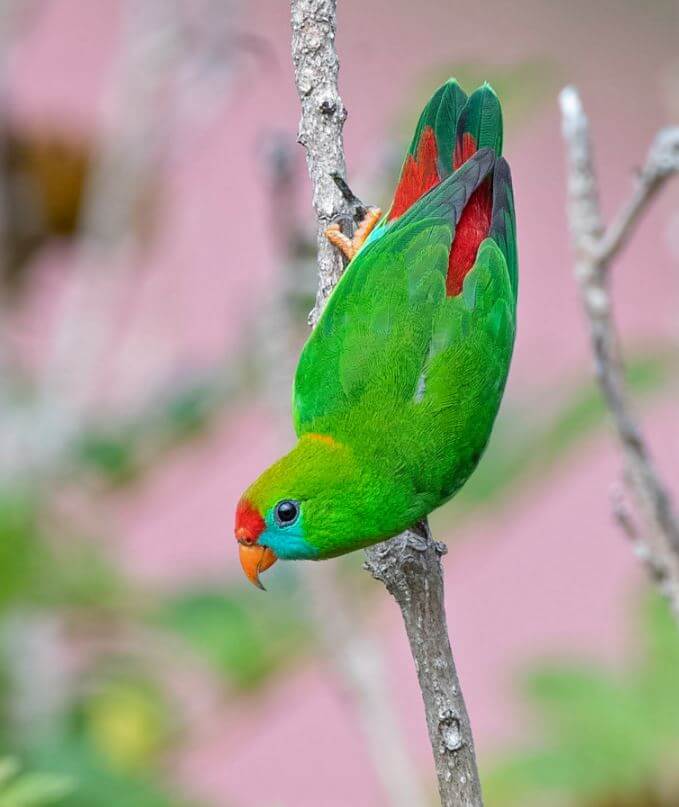Philippine Hanging-parrot (Loriculus philippensis) 14 cm; 31–40 g. Green, more yellowish on undersides; bill orange-red, forehead to mid-crown red bordered by narrow yellow line;
golden-orange patch on nape; large red patch on the throat and upper breast; rump and upper tail-coverts red, sides of rump pale blue; underside of wings and tail pale blue; legs orange.
Female lacks red on the throat and only small red patch on forehead; pale blue area around the base of bill. Immature similar with reduced red on the crown.
Race mindorensis lacks yellowish tones around the crown, nape spot reduced or absent; bournsi with reduced red on the crown with small yellow patch; regulus entire hind crown golden yellow;

chrysonotus hind crown to upper back golden yellow, with orange collar; Worcester entire crown red, orangish-yellow on nape, mantle faintly tinged orange; apicalis similar but mantle washed golden yellow; dohertyi similar but mantle more orange, breast spot larger; siquijorensis hind crown and nape green, smaller throat patch;
camiguinensis has yellowish-green plumage, with red forehead and crown, red rump, light blue face and blue underside of tail; a light blue mutant form has green replaced by pale blue, and other colors paler; iris dark greyish; bill orange to orange-red; legs yellowish horn to fleshy orange; bonapartei with orange hindcrown and nape, bill black, legs dull greyish.
Systematics History
Editor’s Note: This article requires further editing work to merge existing content into the appropriate Subspecies sections. Please bear with us while this update takes place.
Philippine Hanging-parrot (Loriculus philippensis)
Race bonapartei sometimes considered worthy of species status: bill blackish to dark red (score 2) and legs dull greyish vs orange (3), but other claimed differences not constant.
Sol’s “Kulasisi” Philippine Hanging Parrots – Part 1
https://www.youtube.com/watch?v=ebtJIHHuJNU
SOURCE: conniemadjohnnie
Subspecies
Loriculus philippensis philippensis Scientific name definitions
Distribution
Loriculus philippensis mindorensis Scientific name definitions
Distribution
Loriculus philippensis bournsi Scientific name definitions
Distribution
Loriculus philippensis regulus Scientific name definitions
Distribution
Loriculus philippensis chrysonotus Scientific name definitions
Distribution
Loriculus philippensis worcesteri Scientific name definitions
Distribution
Loriculus philippensis siquijorensis Scientific name definitions
Distribution
Loriculus philippensis apicalis Scientific name definitions
Distribution
Loriculus philippensis dohertyi Scientific name definitions
Distribution
Loriculus philippensis bonapartei Scientific name definitions
Distribution

Distribution
Editor’s Note: Additional distribution information for this taxon can be found in the ‘Subspecies’ article above. In the future, we will develop a range-wide distribution article.
Habitat
Philippine Hanging-parrot (Loriculus philippensis)
Forest, forest edge, secondary growth, orchards, coconut groves, bushy areas, and bamboo clumps, generally in lowlands, scarcer above 1250 m, but recorded to c. 2500 m.
Migration Overview
Philippine Hanging-parrot (Loriculus philippensis)
No information, although the species is probably sedentary in the main.
Diet and Foraging
Philippine Hanging-parrot (Loriculus philippensis)
Nectar and blossoms, e.g. of coconuts, and soft fruit such as Ficus. Also takes seeds, particularly of wild bananas (Musa). Seen mostly singly, in pairs, or in small groups.
Sounds and Vocal Behavior
Philippine Hanging-parrot (Loriculus philippensis)
Most often heard is a high-pitched, quickly repeated “tziit-tziit-tziit” (camiguinensis) or “twick twick twick”, given as either one, two, or three notes, which can become a long staccato series, especially when leaving a perch; also gives a rapid “seep seep”.
Colansing or Kulasisi (the Philippine Hanging Parrot)
SOURCE: JDB Comments PRO FILIPINO
Breeding
Mar–May, or Sept–Nov (camiguinensis). Nest recorded in hole 12 m up in dead tree bordering a forest clearing or in the hole in dead tree-fern (camiguinensis). In captivity: three eggs, size (in captivity) 18·4–19 mm × 16·2–16·7 mm (Worcester) or 15·5 mm × 13·7 mm (chrysonotus); incubation lasting 20 days; nestling period c. 5 weeks.
Conservation Status
Not globally threatened. CITES II. Common throughout most of the range; even race bournsi was recently found common at three sites on Sibuyan, being reported as a pest to ripening fruit crops.
However, race regulus judged to be in immediate danger of extinction, owing to the high degree of forest loss throughout its range, although it is known from several protected areas, e.g. Mount Canlaon National Park (Negros); race mindorensis is considered Near Threatened;
race siquijorensis may well now be extinct; and race chrysonotus, although long regarded as extinct, survives in tiny numbers at one site in C Cebu (Central Cebu National Park), the island’s last remaining small patch of forest which continues to be degraded, despite theoretical protected status.
Race camiguinensis probably threatened, present in Mindanao and the Eastern Visayas EBA, and is apparently rare on Camiguin Sur; previously it occurred down to c. 300 m, but nowadays is concentrated in uppermost areas, maybe within just 20 km².
The species is heavily traded within the Philippines, and apart from habitat loss the rarer subspecies may now face or in the past have suffered from trade pressures; the population on Bohol, which may represent an undescribed subspecies, is heavily trapped there and evidently already very scarce.





















